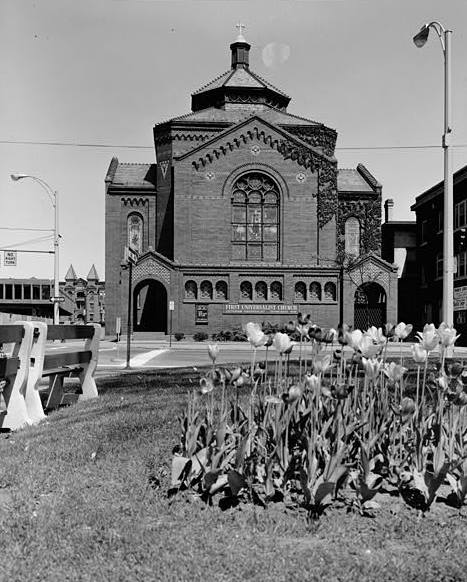First Universalist Church, Rochester New York

The present structure is the second church building of the First Universalist Society of Rochester, incorporated in April 13, 1846. The first church, located on South Clinton Street near Main Street, was completed in 1847. It was used until 1907, when it was sold to the Seneca Hotel, since known as the Manger Hotel.
Claude Bragdon (1866-1946), the architect of the First Universalist Church, studied under Bruce Price and worked for another Rochester architect, Harvey Ellis, before opening his own office in 1901. In 1909, he designed the Rochester New York Central Railroad Station where he attempted to adapt musical ratios to architectural design. This work led to the publication of Art and Geometry by William Ivins. Bragdon became very interested in the philosophy of Louis Sullivan. He edited the first publication of Kindergarten Chats on Architecture, Education and Democracy in 1934. He had contributed the forward to Sullivan's The Autobiography of an Idea, 1926. Bragdon's own writings include Architectural Lectures, 1942; Architecture and Democracy, 1918; The Beautiful Necessity, 1910; Details from Italian Palaces, 1897; Four Dimensional Vistas, 1916; The Frozen Fountain, 1932; Minor Italian Palaces, 1896; More Lives Than One, 1938; A Primer of Higher Space, 1913; Projective Ornament, 1915.
Over-all dimensions: Approximately seventy-five feet by one hundred and fifty feet; five bay west facade; Greek cross plan with rectangular two story accessory building.
A central tower-like portion rises slightly above four gabled wings or arms. The square plan with clipped corners is surmounted by a low octagonal lantern and cupola. Attached to the rear or east side is a rectangular gable-roofed school wing, its long dimension perpendicular to the main axis of the church.
The principal west elevation consists of a projecting one story vestibule, three hays wide, with an arcaded gabled porch at each end. Above it rises the gabled facade of the western arm with wide pilaster strips at the corners, a corbeled cornice following the rake of the gable and a large semi-circular arched window. Flanking it are the north and south arms.
The north elevation is second in importance. The north arm is the dominant element, with three high semicircular arched windows in its upper portion and a small rose window high in the gable. The pilaster strips and cornice are similar to those of the west facade. At the sidewalk level are three rectangular windows with wide sandstone trim. Above them are three rectangular windows and a brick string course with terra cotta coping. At the northwest corner, just above the base course is a sandstone cornerstone bearing the inscription "First Universalist Church of Rochester" and the dates 1846 and 1907- At the east end of this elevation is a slightly lower two story gabled projection, the end of the school wing. Between it and the north arm is a three-bay, two-story element. The bays are marked by pilaster strips. In the center is the secondary entrance, a segmental arched opening surmounted by a gabled hood on small wooden brackets. A succession of small arched windows, three per bay, is located on the second story. This whole asymmetrical elevation is subtly balanced and proportioned.
The east elevation consists of the two-story side of the school wing. Segmental arched windows are grouped in three pairs, with a single one at each end. At the north end of the first story, there are two small rectangular windows.
The south elevation largely resembles the reverse of the north elevation. However, the end of the school wing is plain. A low screen wall connects the lower portions of the two projecting pavilions.




